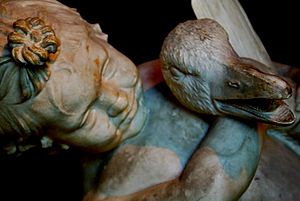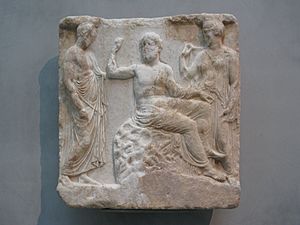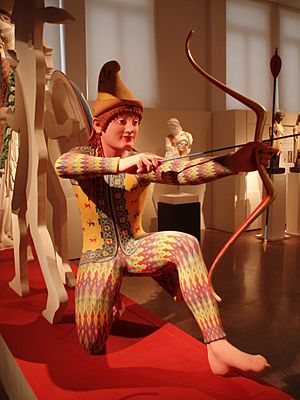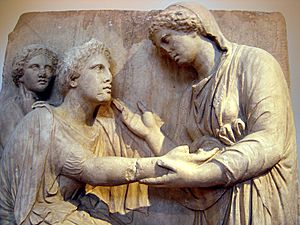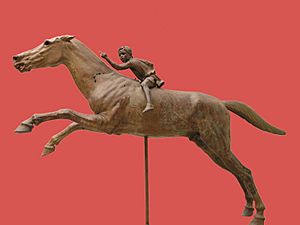Ancient Greek sculpture facts for kids
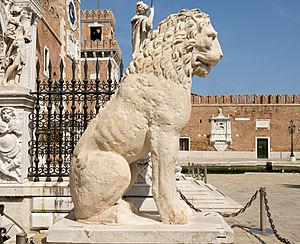
Ancient Greek sculpture is the art of making statues and carvings from ancient Greece. The ancient Greeks believed the human body was very important and even sacred. They thought their gods looked like humans. Because of this, human figures were the main subject for their art.
Greek artists made statues of gods like Apollo or heroes like Heracles. These statues often looked very similar to sculptures of real people, like an Olympic boxing champion. Most Greek sculptures were single statues, but later, during the Hellenistic period, they often created groups of statues. They also made reliefs, which are sculptures carved into a flat surface, sometimes sticking out so much they looked almost like full statues.
Contents
What Greek Sculptures Were Made Of
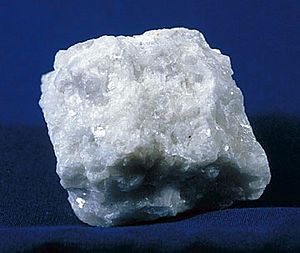
By the Classical period (around the 5th and 4th centuries BC), most large Greek sculptures were made from marble or bronze. Bronze became the favorite material for big artworks in the early 5th century BC. Smaller sculptures were made from many different materials, including valuable ones. There were also many small terracotta (baked clay) figures.
Ancient Greece, except for Sicily and southern Italy, had lots of good quality marble. Pentelic and Parian marble were the most popular types. The metals needed to make bronze were also easy to find.

Both marble and bronze are easy to shape and work with. The Greeks probably also made sculptures from wood, but we know very little about them. One type, called acrolithic sculptures, were often large. Their heads and exposed skin parts were made of marble, but the clothed parts were wood.
Since bronze could be melted down and reused, very few original bronze statues have survived. However, in recent years, marine archaeology (finding things underwater) has uncovered some amazing bronze statues. These finds have greatly helped us understand ancient Greek bronze sculpture. Many Roman copies of Greek statues are marble versions of works that were originally made of bronze.
In the Archaic period, ordinary limestone was used. After that, it was mostly used for architectural sculpture (carvings on buildings) and decoration. Plaster or stucco was sometimes used just for hair.
Chryselephantine sculptures were special and luxurious. They were used for important statues in temples. These sculptures used gold, usually in thin sheets called gold leaf, and ivory for parts of the figure, like faces and hands. They might have also used gems. These were much rarer, and only small pieces have survived.
Many statues had holes for attaching jewelry, and they often held weapons or other objects made of different materials. It's important to know that ancient Greek sculptures were originally painted in bright colors! They look white today because the paint has worn off over time. Some well-preserved statues still show hints of their original colors. Archaeologists can use these clues to figure out how they looked long ago.
Main Periods of Greek Sculpture
Greek sculpture developed through three main stages. During all these periods, many small Greek terracotta figurines and tiny metal sculptures were also made.
Archaic Period
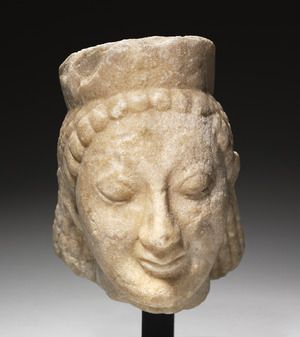
The Greeks started carving in stone again, inspired by the large stone sculptures of Egypt and Mesopotamia. Early Greek statues stood very still and faced forward, like Eastern models. But Greek forms had more detail.
After about 575 BC, these figures, both male and female, started to show a slight smile, known as the "archaic smile." This smile might have been added to make the figures seem more human.
Classical Period
The Classical period brought a big change in Greek sculpture. Some historians link this to the rise of democracy in Athens. During this time, the style and purpose of sculpture changed. Greek sculptors also became much better at showing realistic human forms. Poses became more natural and lifelike.
Around 500 BC, Greek statues began to show real people more often, instead of just mythical figures or general votive statues (gifts to gods). The statues of Harmodius and Aristogeiton in Athens are thought to be the first public monuments to show actual individuals.
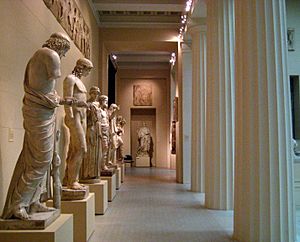
The Classical Period also saw more statues and sculptures used to decorate buildings. Famous temples from this time, like the Parthenon in Athens and the Temple of Zeus at Olympia, used sculpture for decorative friezes (bands of carvings) and other artworks. Most of these works only survive in pieces, such as the Parthenon Marbles, which are now partly in the British Museum.
Hellenistic Period
The shift from the Classical to the Hellenistic period happened during the 4th century BC. Greek art became more varied, influenced by the cultures of the people that Alexander the Great conquered (from 336 to 323 BC). The amazing skill of Hellenistic sculptors is clear in major works like the Winged Victory of Samothrace and the Pergamon Altar.
New centers for Greek culture and sculpture grew in cities like Alexandria, Antioch, and Pergamum. By the 2nd century BC, the growing power of Rome began to take over much of the Greek artistic tradition and many of its artworks.
During this period, sculpture became even more realistic. Everyday people, women, children, animals, and scenes from home life became common subjects. Wealthy families ordered these sculptures to decorate their houses and gardens.
Sculptors created realistic figures of men and women of all ages. They no longer felt they had to sculpt only perfect or beautiful people. At the same time, new Hellenistic cities in Egypt, Syria, and Anatolia needed statues of Greek gods and heroes for their temples and public places. This made sculpture a big industry, much like pottery.
Along with becoming more realistic, sculptures also started to show more power and energy during this time.
Cult Images in Temples
All ancient Greek temples and Roman temples usually had a special statue called a cult image inside the main room (the cella). The most famous Greek cult images were the Statue of Zeus at Olympia and Phidias's Athena Parthenos in the Parthenon in Athens. Both of these huge statues are now completely lost.
Many Greek statues that we know from Roman marble copies were originally temple cult images. For example, the Apollo Barberini was likely one. Very few original cult images have survived. However, the bronze Piraeus Athena, which is 2.35 meters tall, still exists and can be seen in the Archaeological Museum of Piraeus in Athens.
Images for kids
-
The Sabouroff head, an important example of Late Archaic Greek marble sculpture, and a precursor of true portraiture, ca. 550-525 BCE.
-
Phrasikleia Kore, c. 550 BC, Athens, National Archaeological Museum of Athens.
-
Frieze of the Siphnian Treasury, Delphi, depicting a Gigantomachy, c. 525 BC, Delphi Archaeological Museum.
-
Euthydikos Kore. c. 490 BC, Athens, authorized replica, original in National Archaeological Museum of Athens
-
Terracotta vase in the shape of Dionysus' head, ca. 410 BC; on display in the Ancient Agora Museum in Athens, housed in the Stoa of Attalus
-
.
Pottery vessel, Aphrodite inside a shell; from Attica, Classical Greece, discovered in the Phanagoria cemetery, Taman Peninsula (Bosporan Kingdom, southern Russia), early 4th century BC, Hermitage Museum, Saint Petersburg.
-
The Winged Victory of Samothrace (Hellenistic), The Louvre, Paris
-
Sepulchral monument of a dying Adonis, polychrome terracotta, Etruscan art from Tuscana, 250-100 BC
-
Ancient Greek terracotta head of a young man, found in Tarent, c. 300 BC, Antikensammlung Berlin.
-
Female head incorporating a vase (lekythos), c. 325-300 BC.
-
Bronze portrait of an unknown sitter, with inlaid eyes, Hellenistic period, 1st century BC, found in Lake Palestra of the Island of Delos.
-
Greco-Buddhist frieze of Gandhara with devotees, holding plantain leaves, in Hellenistic style, inside Corinthian columns, 1st–2nd century CE. Buner, Swat, Pakistan. Victoria and Albert Museum.
See also
 In Spanish: Escultura de la Antigua Grecia para niños
In Spanish: Escultura de la Antigua Grecia para niños


